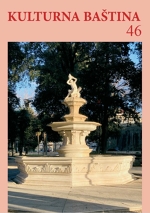TURIZAM U SPLITU KRAJEM 19. I POČETKOM 20. STOLJEĆA
TOURISM IN SPLIT AT THE TURN OF THE 20TH CENTURY
Author(s): Jasenka KranjčevićSubject(s): Theatre, Dance, Performing Arts, Museology & Heritage Studies, Architecture, Local History / Microhistory, Recent History (1900 till today), 19th Century, Tourism
Published by: DRUŠTVO PRIJATELJA KULTURNE BAŠTINE - SPLIT
Keywords: Split; tourism; tourist guides; food service industry; promotion; 19th and 20th centuries;
Summary/Abstract: The development of technology, favourable climate, attractive coastline, rich cultural heritage and other factors encouraged the development of tourism on both the eastern Adriatic coast and in Split in the mid-nineteenth century. Certainly, the main precondition for the development of tourism was the establishment of a permanent maritime and railway line as well as other technical infrastructure. In the previous research into Split, those related to a comprehensive view of the development of tourism and the tourist offer in the City at the turn of the 20th century were omitted. The paper is based on research of Croatian, German, Italian and English resources, i.e. magazines, books, tourist guides and advertisements of individual destinations or catering facilities. In the late 19th century, Split became one of the main tourist destinations on the eastern coast of the Adriatic, and thus one of the most described tourist destinations in guides, travelogues and advertisements. Since Split was not declared a health resort, a large number of visits to Split and its surroundings were related to business and only a smaller part to vacations or medical travels. It is evident from various data, such as magazines and books, that the tourist traffic in Split grew unstoppably from the last decade of the 19th century until the Great War. The port of Split, the attractive area and the tourist offer contributed to this. It is interesting that higher tourist traffic was registered in Split than in Dubrovnik before the Great War. Foreigners or tourists came to Split from all over the world, and most of them came from the Austro-Hungarian Monarchy. The majority of tourists would arrive by sea. The tourist offer in Split did not exclusively include accommodation, restaurants or bathing areas, but was also related to both cultural (tour of architectural heritage, theatre, etc.) and natural attractions (Marjan, Mosor). Despite the great tourist potential, Split was burdened with numerous problems, such as insufficient understanding of the essence of tourism, education of the workforce, business ownership, poor promotion et al.
Journal: KULTURNA BAŠTINA : ČASOPIS ZA PITANJA PROŠLOSTI SPLITSKOGA PODRUČJA
- Issue Year: 2020
- Issue No: 46
- Page Range: 117-139
- Page Count: 23
- Language: Croatian

